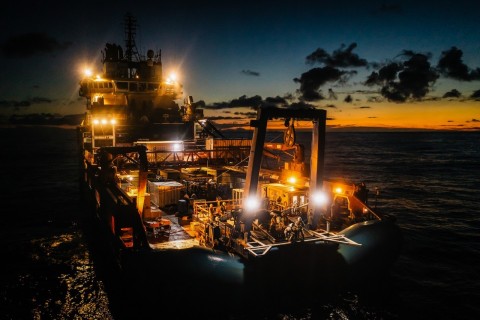The Metals Company Conducts Ground-Breaking Deepwater Sampling Campaign in Eastern Pacific on Path to Meet Global Demand for Critical Minerals
-
The Metals Company has successfully concluded Environmental Expedition 5C, the latest campaign in its$75 million
-
In collaboration with Maersk Supply Services and researchers from the
University of Hawaii ,Texas A&M University and theJapan Agency for Marine-Earth Science and Technology (JAMSTEC), the Company achieved a world first by successfully sampling pelagic biota at depths of 4,000 meters, marking the first deep MOCNESS net tow in theEastern Tropical Pacific Ocean
-
Facing six-meter swells at times, the team endured significant challenges to successfully complete
100% of the work program on schedule and with an untarnished safety record

Researchers from the
“We hear the call for further research into the impact of collecting deep-sea nodules and since 2011 we have been doing just that,” said
Alongside the MOCNESS system, researchers leveraged hydrographic rosettes to determine the physical properties of the water column, generating insights into local salinity, temperature, oxygen, turbidity, nutrient profiles and trace metal content, which will help characterise the inter-relationships between the physical environment from the surface to the abyssal depths, and the animals that live there.
Facing rough seas with swells as high as six meters, both the logistics and research teams overcame significant challenges to complete the scope of the work program on time and without any accidents or incidents. Mobilization of Environmental Expedition 5E, the company’s fifth and final research campaign of 2021, has now commenced and is expected to be completed before the new year. Expedition 5E will mark the completion of the offshore campaigns that will form the basis of the Company’s environmental baseline work.
Planet’s Largest Known Source of Battery Metals
As countries invest in large-scale clean energy transition programs and begin to phase out internal combustion engines, hundreds of millions of tons of critical battery metals including nickel, cobalt, copper and manganese will be needed to decarbonize the world’s energy and transport systems. In the
TMC’s NORI-D nodule project – recently ranked as the #1 nickel project in the world by Mining.com — is the first in the Company’s project development pipeline. In January,
About
TMC the metals company Inc. (
Forward Looking Statements
Certain statements made in this press release are not historical facts but are forward-looking statements for purposes of the safe harbor provisions under The Private Securities Litigation Reform Act of 1995. Forward-looking statements generally are accompanied by words such as “believe,” “may,” “will,” “estimate,” “continue,” “anticipate,” “intend,” “expect,” “should,” “would,” “plan,” “predict,” “potential,” “seem,” “seek,” “future,” “outlook” and similar expressions that predict or indicate future events or trends or that are not statements of historical matters. The forward-looking statements contained in this press release include, without limitation, TMC’s expectations with respect to the success of its research campaign Environmental Expedition 5C, the results or outcomes of the campaigns and expeditions and the data generated during Environmental Expedition 5C respectively. These forward-looking statements involve significant risks and uncertainties that could cause the actual results to differ materially from those discussed in the forward-looking statements. Most of these factors are outside TMC’s control and are difficult to predict. Factors that may cause such differences include, but are not limited to: regulatory uncertainties and the impact of government regulation and political instability on TMC’s resource activities; changes to any of the laws, rules, regulations or policies to which TMC is subject; the impact of extensive and costly environmental requirements on TMC’s operations; environmental liabilities; the impact of polymetallic nodule collection on biodiversity in the CCZ and recovery rates of impacted ecosystems; TMC’s ability to develop minerals in sufficient grade or quantities to justify commercial operations; the lack of development of seafloor polymetallic nodule deposit; uncertainty in the estimates for mineral resource calculations from certain contract areas and for the grade and quality of polymetallic nodule deposits; risks associated with natural hazards; uncertainty with respect to the specialized treatment and processing of polymetallic nodules that TMC may recover; risks associated with collective, development and processing operations; fluctuations in transportation costs; testing and manufacturing of equipment; risks associated with TMC’s limited operating history; the impact of the COVID-19 pandemic; risks associated with TMC’s intellectual property; and other risks and uncertainties indicated from time to time in the final prospectus and definitive proxy statement, dated and filed with the
View source version on businesswire.com: https://www.businesswire.com/news/home/20211108005628/en/
Media | media@metals.co
Investors | investors@metals.co
Source:








